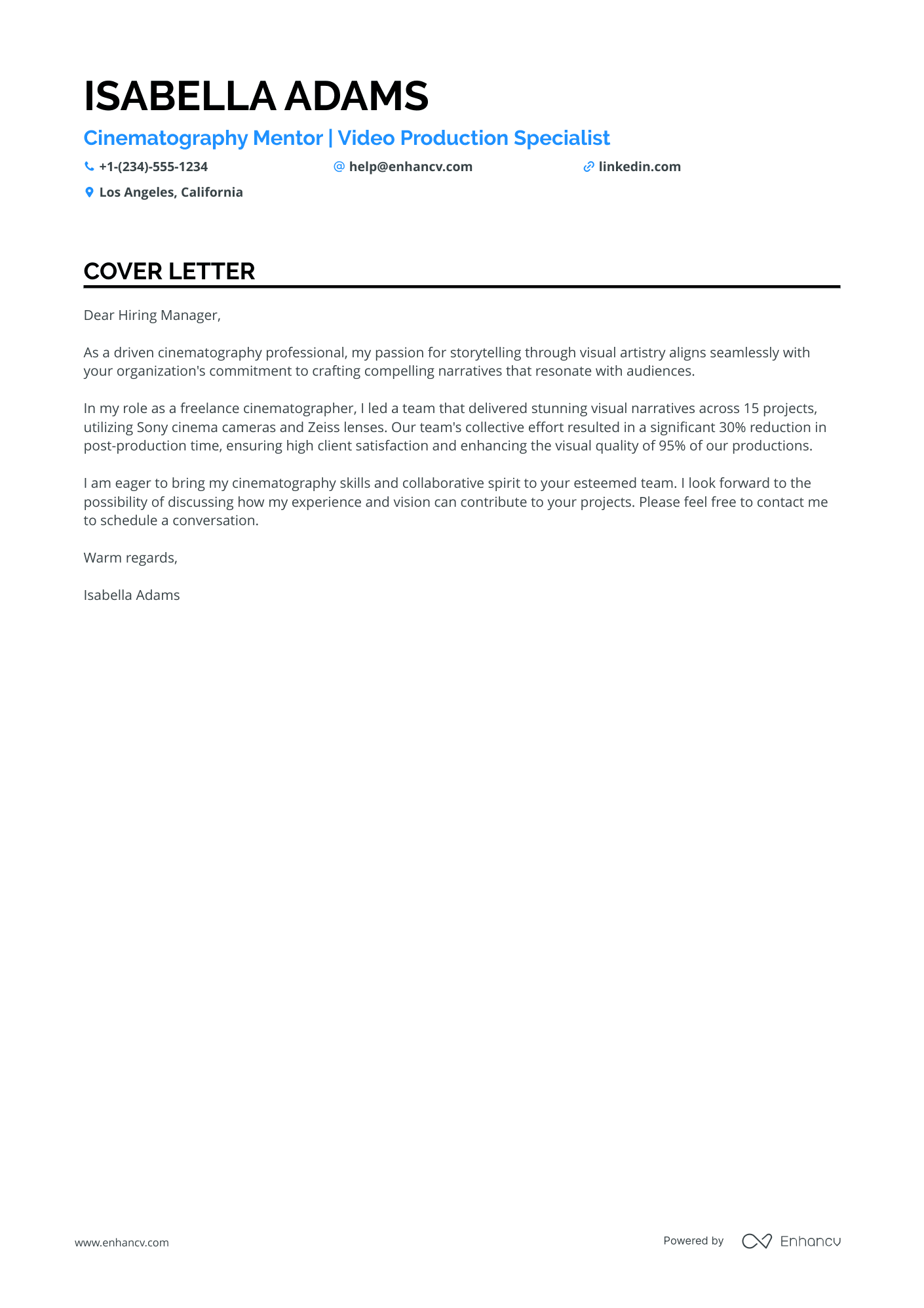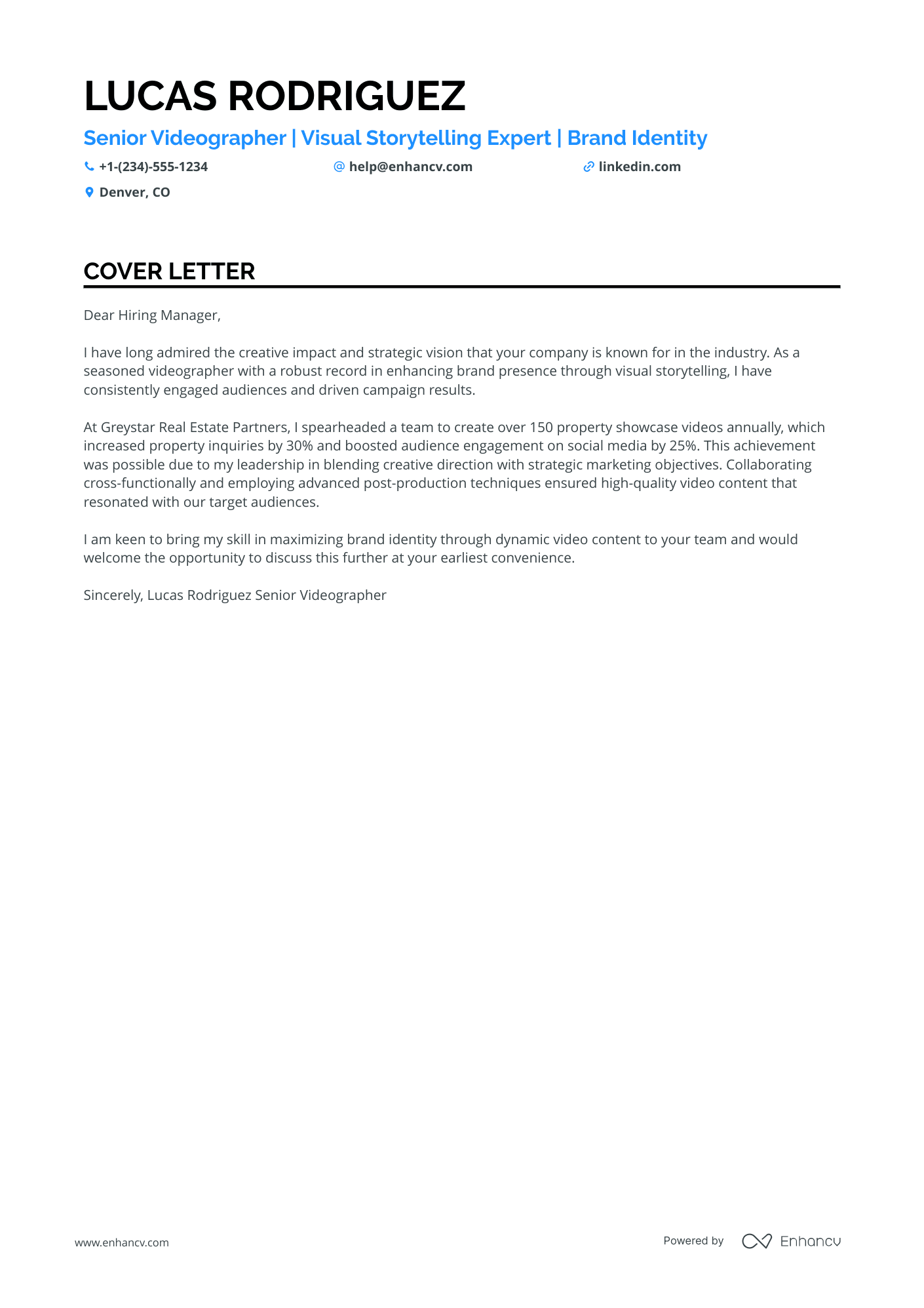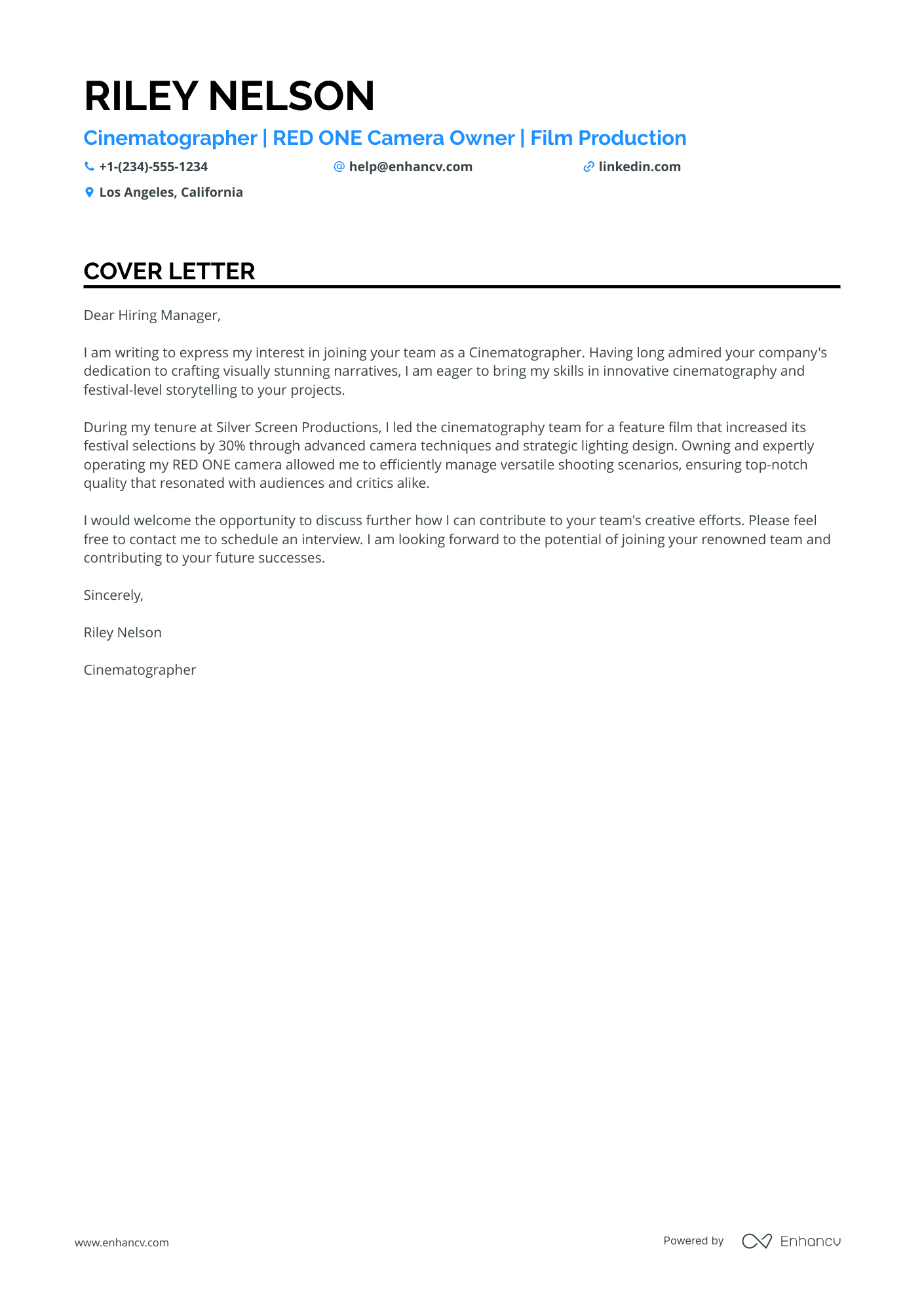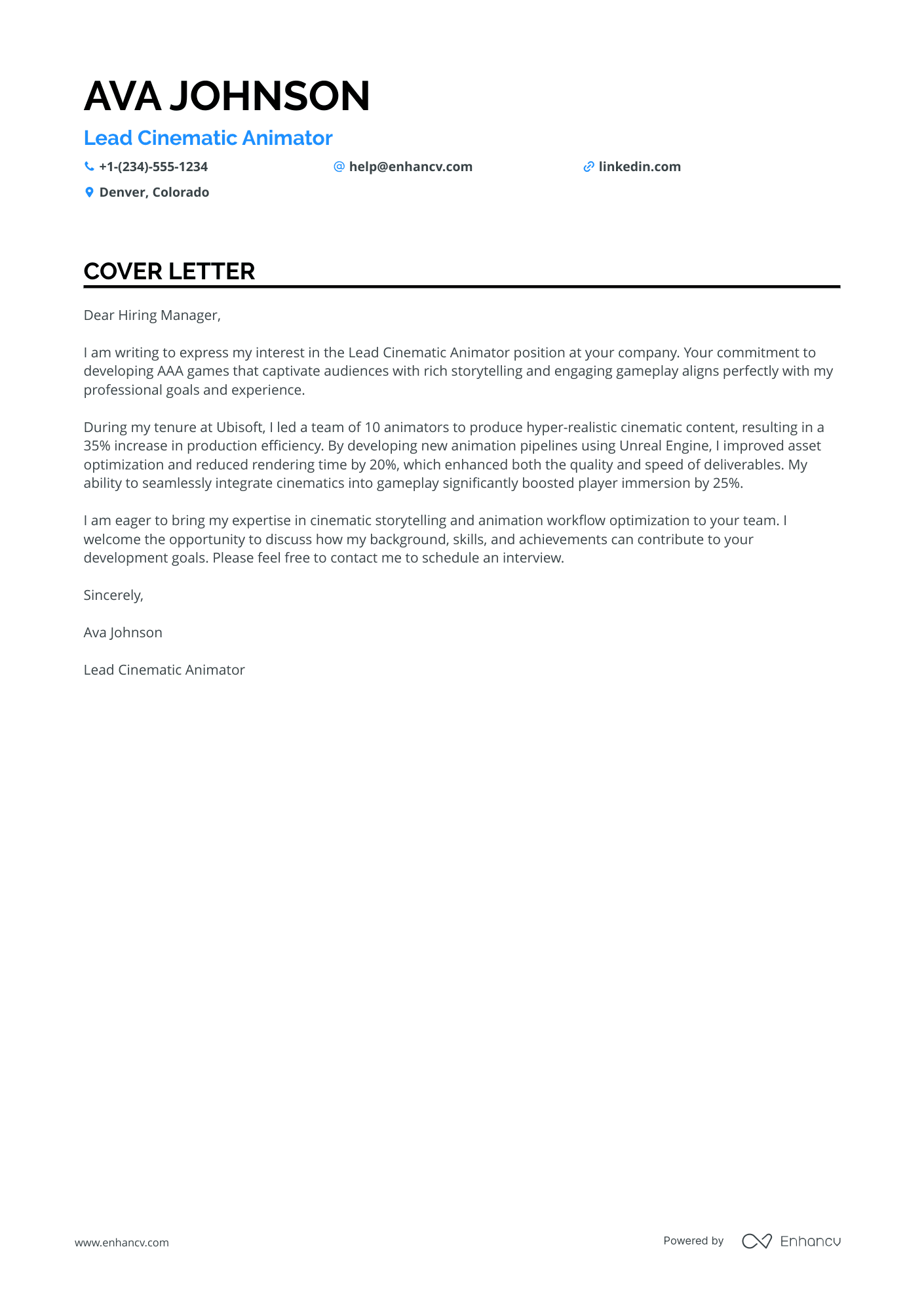Embarking on your journey as a cinematographer, you've likely sent out resumes only to realize that a compelling cover letter is a must-have companion. Your cover letter is your chance to shine a spotlight on a career-defining achievement without just echoing your resume. It must strike a balance between formal tone and refreshing originality, steering clear of worn-out clichés. And remember, this personal feature film of yours should wrap up neatly in one page – credits and all. Ready to roll?
- Personalize your cinematographer cover letter and get inspired by other professionals to tell a compelling story;
- Format and design your cinematographer cover letter to make an excellent first impression;
- Introduce your best achievement in your cinematographer cover letter to recruiters;
- How to make sure recruiters get in touch with you, using your cinematographer cover letter greeting and closing paragraphs.
What is more, did you know that Enhancv's AI can write your cover letter for you? Just upload your cinematographer resume and get ready to forward your job application in a flash.
If the cinematographer isn't exactly the one you're looking for we have a plethora of cover letter examples for jobs like this one:
Drop your resume here or choose a file.
PDF & DOCX only. Max 2MB file size.
Cinematographer cover letter example
Paisley Moore
Fort Worth, Texas
+1-(234)-555-1234
help@enhancv.com
- Professional Experience: Citing a successful past project, such as directing photography for a 12-episode web series, showcases leadership and technical skills relevant to the Cinematographer role.
- Quantifiable Achievements: Mentioning specific metrics, like a 30% increase in subscriber count, provides concrete evidence of the candidate's ability to contribute to audience growth and engagement, which is valuable for a company's success.
- Technical Proficiency: Highlighting expertise with particular camera systems, in this case, Sony, assures potential employers of the candidate's capability to handle the technical demands of the role without requiring additional training.
- Creative Vision: Emphasizing a blend of creative vision and technical competence as a unique selling proposition places the candidate as a valuable asset for a company that prioritizes innovative storytelling.
Designing your cinematographer cover letter: what is the best format
Let's start with the basics, your cinematographer cover letter should include your:
- Header
- Greeting
- Introduction
- Body paragraph
- Closing statement
- Signature (that's not a must)
Next, we'll move to the spacing of your cinematographer cover letter, and yes, it should be single-spaced (automatically formatted for you in our cover letter templates).
Don't go for a old-school font (e.g. Arial or Times New Roman), but instead, pick an ATS-favorite like Chivo, Volkhov, or Raleway, to stand out.
Our cover letter builder is also set up for you with the standard one-inch margin, all around the text.
Finally, ensure your cinematographer resume and cover letter are in the same font and are submitted in PDF (to keep the formatting in place).
P.S. The Applicant Tracker System (or ATS) won't be assessing your [job] cover letter, it's solely for the recruiters' eyes.
Don’t let a busy schedule hold you back. Try our free cover letter generator and build a great letter in seconds.
The top sections on a cinematographer cover letter
Header with Contact Information: Including a header with your name, address, email, and phone number ensures that the recruiter can easily identify and contact you for follow-up discussions or to schedule an interview.
Greeting: A personalized greeting to the hiring manager or the head of the cinematography department demonstrates your attention to detail and shows that you have done your research on the company.
Introduction with Cinematography Specialty: Begin with an engaging opening paragraph that immediately communicates your specific interest and experience in cinematography, highlighting any particular style or technical expertise you bring to the table.
Body Highlighting Visual Storytelling Skills: The body of the cover letter should describe your past projects and how your unique visual storytelling abilities contributed to their success, emphasizing your technical competence with various cameras and lighting setups.
Closing with a Call to Action: Conclude your cover letter by expressing your enthusiasm for the opportunity to collaborate creatively within their team, and suggest a meeting or call to discuss how your vision aligns with their upcoming projects.
Key qualities recruiters search for in a candidate’s cover letter
- Strong visual storytelling skills: Ability to convey narrative and evoke emotions through composition, lighting, and camera movement.
- Technical expertise with camera equipment: Proficiency in operating various cameras, lenses, and ancillary gear to achieve desired aesthetic results.
- Advanced understanding of lighting techniques: Knowledge of how to manipulate lighting to enhance mood, character, and setting.
- Collaborative mindset: Willingness to work closely with the director, production designers, and other departments to ensure a cohesive vision.
- Creative problem-solving abilities: Capacity to address and adapt to unexpected challenges or changes on set quickly and effectively.
- Keen eye for detail: Attention to nuances in color, texture, and space that contribute to the overall quality of the cinematic image.
What greeting should you use in your cinematographer cover letter salutation
A simple "Hello" or "Hey" just won't work.
With your cinematographer cover letter salutation, you set the tone of the whole communication.
You should thus address the hiring managers by using their first (or last name) in your greeting.
But how do you find out who's recruiting for the role?
The easiest way is to look up the role on LinkedIn or the corporate website.
Alternatively, you could also contact the organization via social media or email, for more information.
Unable to still obtain the recruiter's name?
Don't go down the "To whom it may concern path". Instead, start your cover letter with a "Dear HR team".
List of salutations you can use
- Dear Hiring Manager,
- Dear [First Name Last Name],
- Dear [Job Title],
- Dear [Department] Team,
- Dear Search Committee,
- Dear Talent Acquisition Team,
How to start your cinematographer cover letter introduction
The opening paragraph of your cinematographer cover letter can seem like a real enigma.
Where do you start writing?
In your cinematographer cover letter introduction, focus on yourself by stating what:
- gets you motivated and excited about the role;
- you like best about the company, from culture to awards.
Write no more than two sentences, which are both authentic and show your enthusiasm for the opportunity.
Choosing your best achievement for the middle or body of your cinematographer cover letter
Now that you have the recruiters' attention, it's time to write the chunkiest bit of your cinematographer cover letter.
The body consists of three to six paragraphs that focus on one of your achievements.
Use your past success to tell a story of how you obtained your most job-crucial skills and know-how (make sure to back these up with tangible metrics).
Another excellent idea for your cinematographer cover letter's middle paragraphs is to shine a light on your unique professional value.
Write consistently and make sure to present information that is relevant to the role.
Thinking about the closing paragraph of your cinematographer cover letter
Before your signature, you have extra space to close off your cinematographer cover letter.
Use it to either make a promise or look to the future.
Remind recruiters how invaluable of a candidate you are by showing what you plan to achieve in the role.
Also, note your availability for a potential next meeting (in person or over the telephone).
By showing recruiters that you're thinking about the future, you'd come off as both interested in the opportunity and responsible.
Is it beneficial to mention that you have no experience in your cinematographer cover letter?
Lacking professional experience isn't the end of the world for your cinematographer cover letter.
Just be honest that you may not have had roles in the industry, but bring about so much more.
Like, your transferable skills, attained thanks to your whole work and life experience (e.g. the skills your summer spent working abroad taught you).
Or, focus on what makes you, you, and that one past success that can help you stand out and impress recruiters (think of awards you've attained and how they've helped you become a better professional).
Alternatively, write about your passion and drive to land the job and the unique skill set you would bring to enhance the workplace culture.
Key takeaways
Winning recruiters over shouldn't be difficult if you use your cinematographer cover letter to tell a story that:
- Is personalized by greeting your readers and focusing on key job skills greets;
- Isn't spread all over the place, but instead focuses on one key achievement and selling your value as a professional;
- Introduces your enthusiasm for the role, passion for the job, or creativity in communication;
- Is also visually appealing - meeting the best HR practices;
- Ends with a nod to the future and how you envision your growth, as part of the company.
Cinematographer cover letter examples
By Experience
Junior Cinematographer
- Demonstrating relevant experience by mentioning direct involvement in multiple projects, showcasing the candidate's hands-on expertise in the field of cinematography.
- Highlighting technical skills and equipment used (such as Sony cinema cameras and Zeiss lenses), which indicates proficiency with industry-standard tools.
- Emphasizing teamwork and leadership, key qualities in roles where collaboration is essential to achieve project goals and meet client needs.
- Quantifying achievements with specific metrics (like a 30% reduction in post-production time) to provide tangible evidence of the candidate's impact and value.
Senior Cinematographer
- Industry-specific achievements: The letter highlights a significant accomplishment in a previous role that is directly relevant to the position being applied for, such as increasing property inquiries and boosting audience engagement through video content.
- Quantifiable success metrics: It provides specific metrics, like a 30% increase in inquiries and a 25% boost in engagement, which demonstrate the applicant’s ability to deliver tangible results.
- Cross-functional collaboration: Emphasizes the ability to work with different teams, a key skill in producing high-quality content that aligns with broader strategic goals.
- Targeted company knowledge: The introduction mentions admiration for the company’s strategic vision, suggesting that the applicant has researched and respects the company’s industry impact.
Lead Cinematographer
- Highlighting leadership and team management: The cover letter demonstrates the candidate's experience in leading a team of animators, which is crucial for a Lead Cinematic Animator role.
- Emphasizing technical expertise: The mention of developing new animation pipelines and using Unreal Engine showcases the candidate's technical skills, which are essential for the position.
- Quantifying achievements: The letter provides specific metrics, such as a 35% increase in efficiency and a 20% reduction in rendering time, to effectively convey the candidate's impact and capability.
- Focusing on alignment with company goals: The candidate expresses how their personal and professional objectives align with the company's mission, enhancing their suitability for the role.
By Role
Assistant Cinematographer
- Emphasize specialized equipment usage: Highlighting the ownership and expertise with specific equipment, such as the RED ONE camera, showcases the candidate's capability to handle industry-standard tools independently.
- Quantify achievements: Mentioning a precise increase in festival selections due to their work demonstrates the applicant's measurable impact on previous projects, which can be very convincing to hiring managers.
- Tailor the intro to the company's reputation: Aligning personal admiration for the company with one's own aspirations in the job is a personalized touch that explains why the candidate chose to apply to this company specifically.
- Focus on industry impact and creativity: Mentioning the ability to enhance storytelling with innovative cinematography aligns with the creative demands of a cinematographer's role while also reflecting the industry impact they can have.













